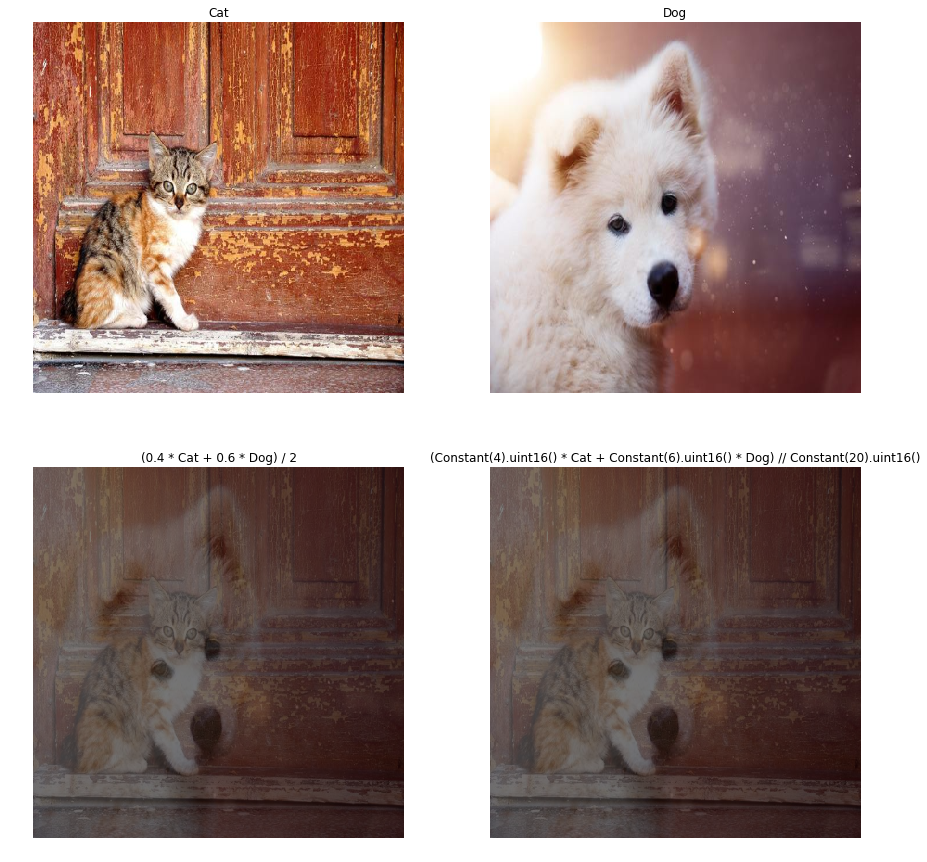Custom augmentations with arithmetic operations¶
This notebook shows how to implement a custom augmentation using expressions with arithmetic operations in define_graph part of the DALI Pipeline.
Blending images¶
We will create pipeline that will blend images in a few different ways. To easily visualize the results, we created two separate file lists for our reader - cats.txt and dogs.txt that contain pictures of cats and dogs.
Imports¶
Lets start with necessary imports.
[1]:
from __future__ import division
from nvidia.dali.pipeline import Pipeline
import nvidia.dali.ops as ops
import nvidia.dali.types as types
from nvidia.dali.types import Constant
Operators used explicitly¶
We don’t need to explicitly list arithmetic operators that we want to use in the Pipeline constructor. They work as regular Python operators in the define_graph step.
As for the rest of Operators, our pipeline will use two separate FileReaders to create two separate batches of tensors, one with cats and one with dogs. We also need an ImageDecoder to decode the loaded images.
Next we need Resize Operator for both inputs - the arithmetic operators are applying pointwise operations between tensors and require them to have matching shape and size. We will settle for 400 x 400 images.
The last operator that we may want to declare in the Pipeline constructor is a Cast operator to convert the data back into desired type.
The graph with custom augmentation¶
Let’s proceed to define_graph. The first few steps are quite obvious: * Load both input batches * Decode both inputs * Resize the inputs to equal sizes
Now we have two variables dogs and cats representing two batches of equal-sized images. Let’s blend those images with some weights and reduce the pixel intensities by half using a formula:
(0.4 * cats + 0.6 * dogs) / 2
Here we used python immediate values as constant inputs to our arithmetic expression.
Using dali.types.Constant to indicate type¶
We can also be more conscious about the types that we use, and do all of the computations in uint16.
As our inputs are in uint8, doing computations with a constant marked as uint16 will promote the results to uint16 (for details of type promotions see “DALI binary arithmetic operators - type promotions” tutorial). We will also use // division that allows us to keep the integer type of the result.
(Constant(4).uint16() * cats + Constant(6).uint16() * dogs) // Constant(20).uint16()
As the last step we return both of the inputs and the results casted back to uint8.
[2]:
class BlendPipeline(Pipeline):
def __init__(self, batch_size, num_threads, device_id):
super(BlendPipeline, self).__init__(batch_size, num_threads, device_id, seed=42)
self.input_dogs = ops.FileReader(device="cpu", file_root="../../data/images", file_list="dogs.txt")
self.input_cats = ops.FileReader(device="cpu", file_root="../../data/images", file_list="cats.txt")
self.decode = ops.ImageDecoder(device="cpu", output_type=types.RGB)
self.resize = ops.Resize(resize_x=400, resize_y=400)
self.uint8 = ops.Cast(dtype=types.DALIDataType.UINT8)
def define_graph(self):
cats_buf, _ = self.input_cats()
dogs_buf, _ = self.input_dogs()
images = self.decode([cats_buf, dogs_buf])
cats, dogs = self.resize(images)
blend_float = (0.4 * cats + 0.6 * dogs) / 2
blend_uint16 = (Constant(4).uint16() * cats + Constant(6).uint16() * dogs) // Constant(20).uint16()
return cats, dogs, self.uint8(blend_float), self.uint8(blend_uint16)
Running the pipeline¶
Let’s create an instance of the Pipelie and build it. We use batch_size = 1 for simplicity of showing the result.
[3]:
pipe = BlendPipeline(batch_size=1, num_threads=1, device_id=0)
pipe.build()
We will use simple helper function to show the images. In case of bigger batches, data_idx can be adjusted to show different samples. The output_titles will be used to set the titles of the Pipeline output.
[4]:
import matplotlib.pyplot as plt
def display(output, titles, cpu = True):
data_idx = 0
fig, axes = plt.subplots(len(output) // 2, 2, figsize=(15, 15))
if len(output) == 1:
axes = [axes]
for i, out in enumerate(output):
img = out.at(data_idx) if cpu else out.as_cpu().at(data_idx)
axes[i // 2, i % 2].imshow(img);
axes[i // 2, i % 2].axis('off')
axes[i // 2, i % 2].set_title(titles[i])
output_titles = [
"Cat", "Dog",
"(0.4 * Cat + 0.6 * Dog) / 2",
"(Constant(4).uint16() * Cat + Constant(6).uint16() * Dog) // Constant(20).uint16()"]
Now, we will run and display the results. You can play this cell several times to see the result for different images.
[5]:
output = pipe.run()
display(output, output_titles)
